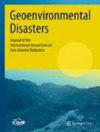Landslide susceptibility assessment of South Korea using stacking ensemble machine learning
IF 4
Q2 ENVIRONMENTAL SCIENCES
引用次数: 0
Abstract
Landslide susceptibility assessment (LSA) is a crucial indicator of landslide hazards, and its accuracy is improving with the development of artificial intelligence (AI) technology. However, the AI algorithms are inconsistent across regions and strongly dependent on input variables. Additionally, LSA must include historical data, which often restricts the assessment to the local scale and single landslide events. In this study, we performed an LSA for the entirety of South Korea. A total of 30 input variables were constructed, consisting of 9 variables from past climate model data MK-PRISM, 12 topographical factors, and 9 environmental factors. Sixteen machine learning algorithms were used as basic classifiers, and a stacking ensemble was used on the four algorithms with the highest area under the curve (AUC). Additionally, a separate assessment model was established for areas with a risk of landslides affecting areas larger than 1 ha. The highest-performing classifier was CatBoost, with an AUC of ~ 0.89 for both assessments. Among the input variables, distance of road, daily maximum precipitation, digital elevation model, and soil depth were the most influential. In all landslide events, CatBoost, lightGBM, XGBoost, and Random Forest had the highest AUC in descending order; in large landslide events, the order was CatBoost, XGBoost, Extra Tree, and lightGBM. The stacking ensemble enabled the construction of two landslide susceptibility maps. Our findings provide a statistical method for constructing a high-resolution (30 m) landslide susceptibility map on a country scale using diverse natural factors, including past climate data.利用堆叠集合机器学习评估韩国的滑坡易发性
滑坡易感性评估(LSA)是滑坡灾害的一个重要指标,随着人工智能(AI)技术的发展,其准确性也在不断提高。然而,人工智能算法在不同地区并不一致,而且在很大程度上依赖于输入变量。此外,LSA 必须包含历史数据,这往往将评估限制在局部范围和单一滑坡事件上。在本研究中,我们对整个韩国进行了 LSA 评估。共构建了 30 个输入变量,包括来自过去气候模型数据 MK-PRISM 的 9 个变量、12 个地形因素和 9 个环境因素。使用了 16 种机器学习算法作为基本分类器,并对曲线下面积(AUC)最高的 4 种算法进行了堆叠组合。此外,还为影响面积大于 1 公顷的山体滑坡风险区域建立了单独的评估模型。表现最好的分类器是 CatBoost,两个评估的 AUC 均为 0.89。在输入变量中,道路距离、日最大降水量、数字高程模型和土壤深度的影响最大。在所有滑坡事件中,按降序排列,CatBoost、lightGBM、XGBoost 和随机森林的 AUC 最高;在大型滑坡事件中,按降序排列,CatBoost、XGBoost、Extra Tree 和 lightGBM 最高。堆叠集合能够构建两个滑坡易感性地图。我们的研究结果为利用各种自然因素(包括过去的气候数据)构建国家级高分辨率(30 米)滑坡易发性地图提供了一种统计方法。
本文章由计算机程序翻译,如有差异,请以英文原文为准。
求助全文
约1分钟内获得全文
求助全文
来源期刊

Geoenvironmental Disasters
Social Sciences-Geography, Planning and Development
CiteScore
8.90
自引率
6.20%
发文量
22
期刊介绍:
Geoenvironmental Disasters is an international journal with a focus on multi-disciplinary applied and fundamental research and the effects and impacts on infrastructure, society and the environment of geoenvironmental disasters triggered by various types of geo-hazards (e.g. earthquakes, volcanic activity, landslides, tsunamis, intensive erosion and hydro-meteorological events).
The integrated study of Geoenvironmental Disasters is an emerging and composite field of research interfacing with areas traditionally within civil engineering, earth sciences, atmospheric sciences and the life sciences. It centers on the interactions within and between the Earth''s ground, air and water environments, all of which are affected by climate, geological, morphological and anthropological processes; and biological and ecological cycles. Disasters are dynamic forces which can change the Earth pervasively, rapidly, or abruptly, and which can generate lasting effects on the natural and built environments.
The journal publishes research papers, case studies and quick reports of recent geoenvironmental disasters, review papers and technical reports of various geoenvironmental disaster-related case studies. The focus on case studies and quick reports of recent geoenvironmental disasters helps to advance the practical understanding of geoenvironmental disasters and to inform future research priorities; they are a major component of the journal. The journal aims for the rapid publication of research papers at a high scientific level. The journal welcomes proposals for special issues reflecting the trends in geoenvironmental disaster reduction and monothematic issues. Researchers and practitioners are encouraged to submit original, unpublished contributions.
 求助内容:
求助内容: 应助结果提醒方式:
应助结果提醒方式:


